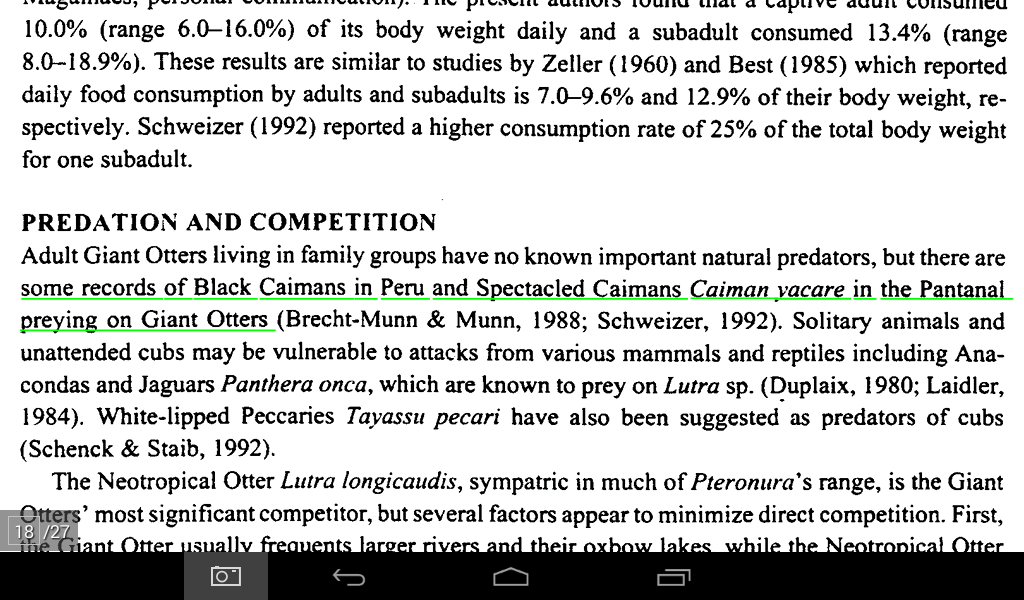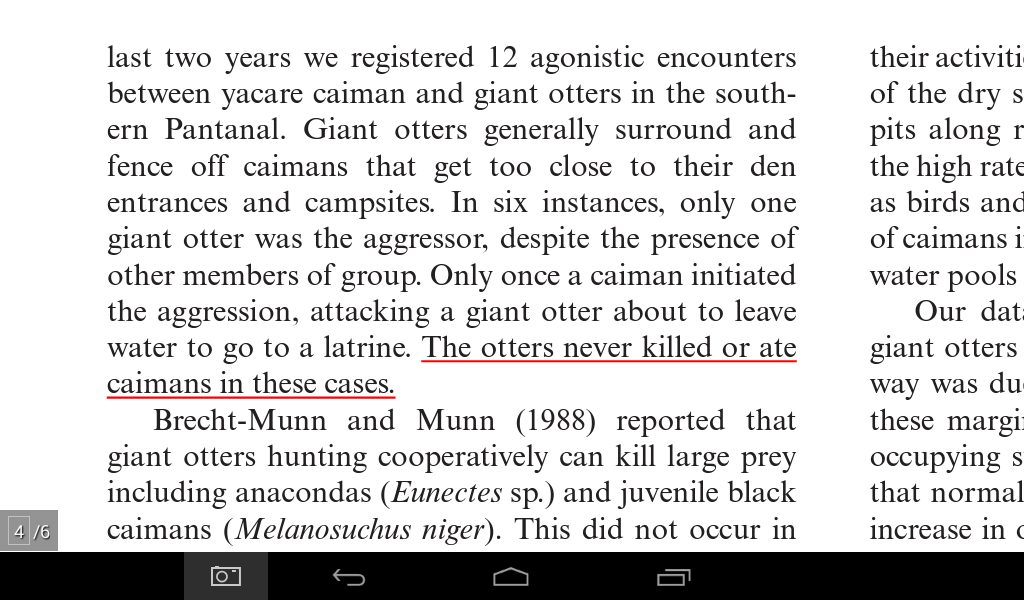Post by Ceratodromeus on Nov 28, 2015 1:29:42 GMT 5
Giant otter - Pteronura brasiliensis

The giant otter (Pteronura brasiliensis) is a South American carnivorous mammal. It is the longest member of the Mustelidae, or weasel family, a globally successful group of predators. Unusually for a mustelid, the giant otter is a social species, with family groups typically supporting three to eight members. he giant otter shows a variety of adaptations suitable to an amphibious lifestyle, including exceptionally dense fur, a wing-like tail, and webbed feet. The species prefers freshwater rivers and streams, which are usually seasonally flooded, and may also take to freshwater lakes and springs. It constructs extensive campsites close to feeding areas, clearing large amounts of vegetation. The giant otter largely subsists on a diet of fish, particularly characins and catfish, and may also eat crabs. It has no serious natural predators other than humans, although it must compete with other species, including the Neotropical otter and caiman species, for food resources. The giant otter is clearly distinguished from other otters by morphological and behavioural characteristics. It has the greatest body length of any species in the mustelid family, although the sea otter may be heavier. Males are between 1.5 and 1.7 m (4.9 and 5.6 ft) in length from head to tail and females between 1 and 1.5 m (3.3 and 4.9 ft). The animal's well-muscled tail can add a further 70 cm (28 in) to the total body length. Early reports of skins and living animals suggested exceptionally large males of up to 2.4 m (7.9 ft); intensive hunting likely reduced the occurrence of such massive specimens. Weights are between 26 and 45.3 kg (57 and 100 lb) for males and 22 and 26 kg (49 and 57 lb) for females.
Yacare caiman - Caiman Yacare

The Yacare caiman (Caiman yacare, Jacaré in Portuguese) is a species of caiman found in central South America, including northeastern Argentina, Uruguay eastern Bolivia, central/south-west Brazil, and the rivers of Paraguay. Approximately 10 million individual Yacare Caiman exist within the Brazilian Pantanal, representing what is quite possibly the largest single crocodilian population on Earth. As a medium-small sized crocodilian, most adult male individuals grow to roughly 2 or 2.5 m (6.6 or 8.2 ft) in length, with the occasional 3 m (9.8 ft) individual (there are reports of occasional 4 m (13 ft) individuals within the Pantanal, but this is yet to be verified). Females are rather smaller at an average of 1.4 m (4.6 ft). Body mass in this species can range up to 58 kg (130 lb) in males and from 14 to 23 kg (31 to 51 lb) in females

The giant otter (Pteronura brasiliensis) is a South American carnivorous mammal. It is the longest member of the Mustelidae, or weasel family, a globally successful group of predators. Unusually for a mustelid, the giant otter is a social species, with family groups typically supporting three to eight members. he giant otter shows a variety of adaptations suitable to an amphibious lifestyle, including exceptionally dense fur, a wing-like tail, and webbed feet. The species prefers freshwater rivers and streams, which are usually seasonally flooded, and may also take to freshwater lakes and springs. It constructs extensive campsites close to feeding areas, clearing large amounts of vegetation. The giant otter largely subsists on a diet of fish, particularly characins and catfish, and may also eat crabs. It has no serious natural predators other than humans, although it must compete with other species, including the Neotropical otter and caiman species, for food resources. The giant otter is clearly distinguished from other otters by morphological and behavioural characteristics. It has the greatest body length of any species in the mustelid family, although the sea otter may be heavier. Males are between 1.5 and 1.7 m (4.9 and 5.6 ft) in length from head to tail and females between 1 and 1.5 m (3.3 and 4.9 ft). The animal's well-muscled tail can add a further 70 cm (28 in) to the total body length. Early reports of skins and living animals suggested exceptionally large males of up to 2.4 m (7.9 ft); intensive hunting likely reduced the occurrence of such massive specimens. Weights are between 26 and 45.3 kg (57 and 100 lb) for males and 22 and 26 kg (49 and 57 lb) for females.
Yacare caiman - Caiman Yacare

The Yacare caiman (Caiman yacare, Jacaré in Portuguese) is a species of caiman found in central South America, including northeastern Argentina, Uruguay eastern Bolivia, central/south-west Brazil, and the rivers of Paraguay. Approximately 10 million individual Yacare Caiman exist within the Brazilian Pantanal, representing what is quite possibly the largest single crocodilian population on Earth. As a medium-small sized crocodilian, most adult male individuals grow to roughly 2 or 2.5 m (6.6 or 8.2 ft) in length, with the occasional 3 m (9.8 ft) individual (there are reports of occasional 4 m (13 ft) individuals within the Pantanal, but this is yet to be verified). Females are rather smaller at an average of 1.4 m (4.6 ft). Body mass in this species can range up to 58 kg (130 lb) in males and from 14 to 23 kg (31 to 51 lb) in females








 . Am I the only one who'd actually want to see something like that in real life?
. Am I the only one who'd actually want to see something like that in real life?
